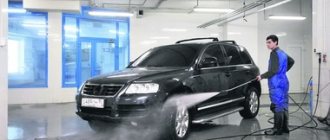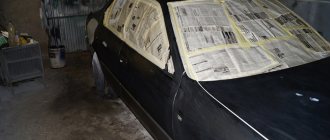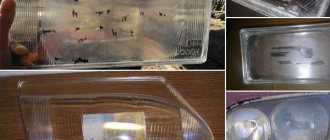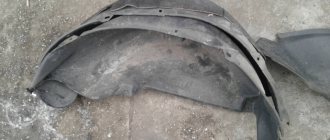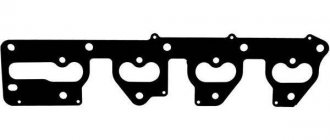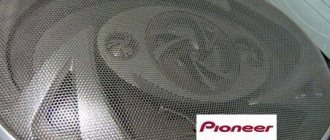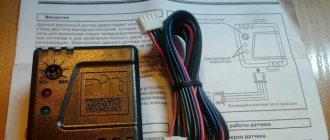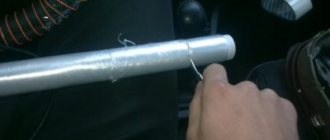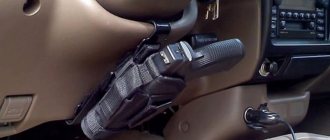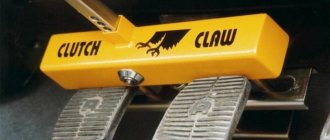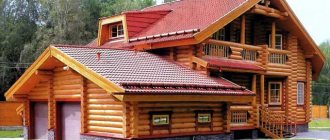Every car owner is faced with the need to putty a vehicle if it has been in an accident, received dents, or simply has rust on the body. Puttying is an integral element of car body repair. This is a complex and time-consuming procedure that needs to be learned. Skills and abilities come with experience. Only a person who knows his business can achieve an ideal result. It is worth noting that putty is the thickest finishing layer of a car body, since quite a lot of material has to be applied to level the surface. And the smoother the layer, the less you will have to sand the surface of the car after that.
Difference between primer and putty
Such questions arise because novice craftsmen do not fully understand (or do not understand at all) how one material differs from another, and also do not distinguish between their role in the process of creating a new or repairing damaged paintwork on a car. Let's start with the primer, since it is a mandatory step in painting the body parts of the car.
The main task of the soil is to create reliable adhesion between the coating and the base metal. In addition, his tasks include:
- Pore filling. If you examine any smooth-looking surface through a microscope, it turns out that it may contain a lot of pores. There is no escape from this, since this is the structure of the surface layers of any material (including metal). Accordingly, air will accumulate in the pores, which prevents reliable adhesion of the paint and the surface.
- Separation of conflicting coverages. Sometimes the painting process requires the application of several layers with different properties, which can cause rejection due to lack of adhesion (adhesion).
- Anti-corrosion protection. Creating a protective barrier on the metal surface that prevents contact with air or water.
Automotive putty in its finished form is a plastic mass used to correct existing surface defects. Obviously, the cavities of cracks, chips or dents must be filled first, otherwise no painting can guarantee an acceptable result. It will, of course, add color, but visible unevenness will remain.
So, no primer is applied under the putty. The opposite happens: first, the surface is puttied to eliminate the visible defect, and only then primed to provide a reliable base for the paintwork.
How to dilute material
Automotive putty (AS) is a finishing material produced in powder or paste form. The paste can be used immediately, but the powder must be diluted in accordance with the attached instructions. If the recommendations are not followed, the solution may simply not lie on the work surface and often cracks after drying.
Fiberglass mortar is easier to prepare because it is not subject to air saturation. Kneading a polyester product requires more careful adherence to the instructions. The percentage of hardener should not exceed 1.5-2 units of the total mass. Experienced car enthusiasts use a rather unusual but effective technique. The hardener is squeezed out crosswise to the required amount of ash. That is, two diameters perpendicular to each other are extruded onto the mass of the component, laid out in the approximate shape of a circle.
It is also necessary to knead using a certain technology: with strokes, in order to prevent excessive entry of air mass and, as a result, porosity of the solution structure.
There are main points worth paying attention to:
- For grinding, you need to allocate an area slightly larger than the area being repaired;
- the solution is applied only to a cleaned and degreased part;
- you need to use only clean tools;
- follow the mixing technology;
- strictly follow the instructions regarding the required amount of hardener;
- the working time of the putty is 5-10 minutes, during which you need to have time to apply it to the surface;
- the composition must be stirred in portions due to the short duration of its use;
- Usually two layers are applied with an interval of half an hour.
Quite often the question comes up: how to dilute dried putty? Ideally, it is better not to use such a composition, since it loses all its properties. But if necessary, you can use a neutral solvent or a product recommended by the manufacturer.
Which putty is better and how to use it
Since we have already understood a little about how one component differs from another, it would not be amiss to consider the issue of their selection and practical application. Automotive putty is selected depending on the existing situation regarding the active base substance.
| Type | Application | Peculiarities |
| Fiberglass. | Used to level out large dents as a rough layer. Has good elasticity. | Creates a reliable reinforcing layer. It is quite difficult to process and requires leveling with a finishing layer. |
| Universal coarse grain. | Also applies to coarse putties with high elasticity. | Its advantages are good adhesion and low shrinkage. |
| Fine-grained. | This is a finishing automotive putty that is used to remove pores in metal and level the surface before priming. | Easy to process, can be used for parts made of fiberglass and plastics. |
| Acrylic. | Used for processing large areas. Can successfully replace finishing mass. | It differs from previous types in its liquid structure. It is a kind of putty primer because it can be directly coated with paint. |
Before applying the main mass, the surface must be thoroughly treated. This process includes sanding, removing old coating, rust, dust and degreasing. Next, an anti-corrosion primer and putty can be applied, which will have an additional adhesion effect. This is perhaps the only case when the base is created under putty. The main mass is applied in 2–3 layers with a total thickness of up to 3 mm. It is not recommended to do more, since large internal stresses arise in the putty, and it can simply crack.
Allow 20 minutes to dry before applying the next coat.
Possible mistakes when applying putty
Those who are just learning how to properly putty a car need to know about some basic recurring mistakes that need to be carefully avoided:
- It is important not to take the process of applying rough putty lightly. For example, if the area is very poorly processed, it is not recommended to move further, since the whole thing will have to be done from scratch;
- In the complete absence of theoretical and practical knowledge, if the puttying technology is not known, it is not worth taking on the job. In this situation, it would be more effective to seek help from professionals or to carry out this process for the first time under the guidance of professionals. In this way, you can save a large amount of material resources and time;
- If there are only scratches on the vehicle after an unsuccessful trip or a minor accident, it is not at all necessary to carry out the putty process. It is enough to get by with simpler methods of eliminating them.
Selecting and applying a primer
When the surface geometry has been completely recreated, you can begin to treat with primer, which will ensure reliable adhesion of the paint layer. Before this, a few words have already been said about the properties of the primer, which mainly determine its classification. Let's consider its types in more detail.
- Epoxy. This is a liquid mixture containing chromium plating or inert substances. Used to counteract moisture and other aggressive compounds. Such primers (for example, GF21, FL-OZK) do not require finishing sanding. Except for cases where the paintwork has visible defects (drips).
- Primer. This is the so-called primary primer, or leveler. It is used for anti-corrosion treatment (can be applied before puttying) and improving adhesion.
- Sealant. This is the finishing layer of primer, which is designed to protect it and deactivate the solvent properties of the paint.
Purpose and application
Depending on the type of repair work being carried out, it must be borne in mind that the car putty should also be different, providing the best effect when using this substance. Let's look at the types of leveling agents and what they are intended for:
- Aerosol. Available in the form of a spray, it is used for the final treatment of large parts of the car body. To remove roughness caused by grinding, the so-called liquid putty is used, which is sprayed over the coating, which ensures an even layer;
- Closing pores. An acrylic product with one main component is used. It is necessary to eliminate surface unevenness after priming. It is produced as a ready-made composition; you just need to squeeze it out of the tube and spread it evenly over the body;
- Containing aluminum impurities. A very elastic product that does not allow large shrinkage of the material. It is used for repairing plastic surfaces, as well as minor dents or scratches. This putty will help protect the vehicle from cracks;
- Having a fiberglass structure. This putty is indispensable when it is necessary to repair deep cracks, significant rusty areas, dents and large irregularities. Considered as the initial coarse layer on which the finishing fine-grained substance will be applied;
- Suitable for plastic components. This putty is very convenient when carrying out repair work, as it has excellent elasticity;
- With plasticizers included in the composition. Used when the impact on the vehicle is minor. The putty has good contact with polymers, penetrating deeply into their structure.
Important! Before starting work on puttying a car with your own hands, you should purchase not only putty, but also sandpaper, primer, varnish, paint and material that will cover undamaged parts of the car.
Do-it-yourself car repair, putty
- To carry out the work, the first thing you should do is put on protective disposable gloves. Now you can proceed directly to the work itself - straightening the dent. When straightening, the main thing is not to overdo it, otherwise you may end up with a bulge instead of a dent. The next step is to apply the filler so that the layer thickness does not exceed 5 - 6 mm. We clean the dent using a pre-purchased wipe from an auto store. Now we thoroughly clean the surface of the dent, removing any dirt that has formed.
- To identify minor defects that are not noticeable at first glance, the dent assessment should be carried out with the palm of your hand rather than with your fingers. This will allow you to better estimate the size of defects from a very small defect.
- Now you can start cleaning the surface from paint and possible corrosion. We clean the surface of the dent with our own hands, covering the surrounding areas. To speed up the grinding process, it is wise to use a grinding wheel. After the surface has been sanded, it must be cleaned again. To ensure proper cleaning, simply wiping or blowing the surface of the dent is not enough. It is better to use a panel wipe.
- Automotive stores sell two types of putty: a mixture for repairs with putty by professionals and a mixture for do-it-yourself repairs - for amateurs. When choosing putty there is one point that needs to be taken into account. This is the presence of galvanized parts in your car. Read the instructions for using the putty, from which you can find out whether the putty can be used without first sanding and priming.
- Another very important factor for successful DIY repairs is strict adherence to the proportions of hardener and filler at the time of mixing them. For these purposes, you can use scales. The best option would be to use a device called a dispenser. With its help, you will not only be able to prepare the correct ratio of mixture ingredients, but also preserve a large amount of putty for a long time. It is worth paying attention to what material the surface on which the putty is prepared is made of. Cardboard should not be used for this purpose. Cardboard, if the mixture is prepared on it, will change the overall composition of the putty due to the air content. Some of the components will simply be absorbed into the cardboard. A clean plastic or metal sheet is suitable for this work.
- To prepare the putty mixture with your own hands, you need to pick up the hardener with a spatula, pour it onto the filler, and press it with the spatula so as to push it through the mixture. To produce a mixture that includes fiberglass, other working methods are used. By pressing the hardener, you remove air from the mixture. Basically, the components of the mixture are colored in different colors, which makes the process of preparing the mixture easier. Trying to speed up the drying process, some car enthusiasts add an increased amount of hardener to the mixture, which ultimately leads to the fact that the putty becomes brittle after drying.
- The next step in repairing a body dent with your own hands is to putty the prepared surface. Apply the putty using a pressing motion, and the direction of movement should go from top to bottom and at the same time to the sides. The main requirement is to make the surface of the dent as smooth as possible so that no areas with a convex surface are formed (no waves). This work must be done quickly, because if you hesitate, the putty will dry out and will be unsuitable for further use.
- The drying time for amateur mixtures intended for putty repair work takes approximately half an hour. For professional mixtures - 15 minutes. It is advisable to apply a dry developing coating of a contrasting color to the surface of the dried putty.
- It's time for sanding. First of all, it is necessary to protect from damage the surface that does not need sanding. At the initial stage of sanding, use P80 sanding paper. In some cases, in the instructions for using the putty, the manufacturer indicates which sanding paper should be used. During sanding, you will see that the contrasting color coating wears off unevenly and small “dimples” form. If this happens, then it is necessary to putty the surface of the dent again.
- Once you've done the initial sanding, remove the resulting dust and continue sanding by hand, this time using P180 paper, and later using P280-320 paper. Sanding must be done carefully, since any missed scratch will be visible after painting. When sanding, never wet the surface of the work. The fact is that the water will be absorbed, and after some time, small bubbles in the paint will form on the surface of the repaired area, as well as corrosion. The putty may peel off.
- During sanding, you must constantly remove dust using a vacuum cleaner or brush. It is advisable to use a protective mask during the grinding process, because the resulting dust is omnipresent. Experts remove dust using special adhesive tape.
- If the dent on the car body is quite large, then a situation may arise when it will have to be puttyed several times. The work process is the same as in the first case. It is advisable to use professional putty as it dries faster.
- After applying the next layer of putty, after sanding, check the smoothness of the layer with your own hands. Moreover, this check should always be done using the palm of your hand. Do not use the vehicle until the repaired area has been painted. The unpainted surface of the putty will absorb moisture.
- The putty itself is practically harmless, but dust that gets into the lungs during repair work on grinding, as well as after mixing the composition, is not removed from them. It is better to take care of yourself before carrying out work, and equip yourself properly - wear a mask, gloves, goggles and, of course, old clothes over your overalls.
- Good tools are part of good work! To successfully repair a car dent with your own hands, you will need a spatula, and everything else that you use during sanding, putty (paper), paint remover, etc. In order for the spatula to last a long time, do not forget to thoroughly clean it of putty upon completion of repair work. If you use a contaminated spatula when filling a dent in a car body, then you can’t expect a good result after the work done. To carry out high-quality metal grinding, it is better to use special pneumatic or electric grinding machines. Firstly, they reduce surface treatment time, and secondly, they save your energy.
Composition and technical characteristics
Automotive putty is used to eliminate damage and unevenness on the surface of metal and plastic parts, so it must have a viscous consistency.
All putty data must:
- Have good adhesion to the treated coating;
- Possess the ability to spread evenly with the surface;
- Sag as little as possible after hardening occurs;
- Easy to handle.
Attention! High-quality putty cannot be fragile!
Putties usually contain one of the following substances:
- Acrylic;
- A mixture containing nitrocellulose;
- Polyester resin.
Based on the presence of the main components, they are distinguished:
- One-component putty. If nitrocellulose is present in the base, then it is the final repair layer, but the drying process takes a long time. With an acrylic base, the slightest defects are removed, such as marks after sanding;
- Two-component putty. A more popular option, the main substances of which are epoxy or polyester resin. Before use, the putty is mixed with a hardener, which is present in the mixture in small quantities. Unlike polyester putties, epoxy putties take a long time to dry and are difficult to process, but coatings can be applied to them without an insulating layer.
Consumption per 1 m2
Depending on the type of putty and the material it is based on, the consumption for a specific area varies significantly. If a finishing agent is used to level out uneven surfaces of a car, the layer is small, and therefore a small amount of putty is required.
Application technology
The composition must be applied in a certain way. Using the end of a spatula, remove as much putty as required and apply it to the middle of the work area. The spatula is moved, gradually pressing against the surface so that the angle between them decreases. It is better to do the final step with a large spatula that exceeds the size of the area being corrected. Finish sanding is carried out with fine sandpaper. On convex surfaces it is better to use a silicone or rubber tool.
Advantages and disadvantages
Each type of car putty has its corresponding pros and cons:
- Rough putty can be used with almost any type of finishing coating, is resistant to temperature changes, very elastic, and has good plasticity. The only disadvantage is that the drying time is quite long;
- Putty with fiberglass is easy to process during the grinding process, has great strength, and will last a significant period of time;
- Finishing agents for repairs adhere well to other types of putties, are very elastic and resistant to temperature changes. This type can quickly harden, so it is not recommended to use it when using a large amount of the prepared mixture in order to facilitate processing of the applied layer;
- Liquid materials are easy to use and can be used on damaged areas of various sizes. The advantages include the ability to process a large surface in a short time, but the disadvantage is the rather high rate of hardening of the mixture;
- The main advantage of the universal coating is the ability to carry out very quick body repairs. This mixture has a strong structure and, when used correctly, forms a fairly smooth surface.
Polishing pastes – how to choose the right one?
Polishing materials for car painting are necessary at the final stages of painting a car - with their help, an even and beautiful shine of the coating is formed. At the first stage, abrasive polishing is performed, which ensures the removal of a thin layer of paintwork on the car body. Several removals are carried out using polishing pastes with different grain sizes.
To restore a body surface damaged by minor defects, it is necessary to use fine-grained compounds, while to eliminate extensive damage, it is advisable to use only coarse-grained polishing pastes. The choice of paste at each specific stage of polishing depends solely on the condition of the body coating. To ensure proper application of the paste, it is recommended to use special polishing equipment.
WATCH VIDEO INSTRUCTIONS
Buy high-quality automotive paint and varnish materials and equipment from trusted manufacturers so that painting your car yourself in a garage environment will be successful. Follow the painting instructions and don't skip the important steps of priming, filling and polishing. In this case, the paintwork of the car will last a long time.
Types of automotive putties
Based on the principle of use, putty can be divided into the following types:
- Having a general purpose. These include universal ones, with a lightweight structure, and also soft ones. The main substance is talc, or quartz microspheres with an empty body, providing lightness of the mixture and ease of stirring and application. Usually spread in a small layer over the surface of the damage, previously cleaned of rust;
- With a certain specific purpose. They, in turn, are divided into corresponding types:
- Reinforced with fiberglass. A very practical material with moisture-repellent properties, is quite plastic, and can be used even when applied in a thick layer. The fiber can be either short or long, both of which are not recommended for use on plastic parts. Do not apply to coatings exposed to temperature changes;
- With carbon fiber reinforcement. The advantages are strength and elasticity; it is better to cover the surface in several layers, since this type has significant fragility and is susceptible to cracks;
- Containing aluminum dust. You may experience difficulty mixing the mixture with the hardener. If the material has been applied correctly, water-repellent properties are formed, heat is well tolerated, therefore it is often used when repairing the hood, as well as when processing the seam after welding;
- Specially designed for application to bumpers. Very elastic and vibration-resistant, bonds well with plastic. When applied, apply in a small thickness;
- Spraying. It is used as a final layer, sprayed from a spray gun over a large area of damage. This putty should be mixed with a hardener, which is also in a liquid state, and after drying, the coating must be sanded and coated with a primer;
- Finishers. Apply at the final stage of repair. Due to the low viscosity, a thin spread over the surface is ensured, with a thickness of less than two millimeters;
- Having only one component. This is an independent mixture that does not need to be combined with a hardener. Only minor damage left after leveling can be covered up. Apply over the primer, right before the painting process.
Putty rules
To get a high-quality, smooth surface after puttying, you need to follow some rules:
- Degrease and clean the damaged area;
- Combine putty and hardener in the correct proportions, depending on the expected effect.
Important! It is not necessary to use a lot of hardener; too much will lead to cracks.
Applying automotive putty to the ground
It is recommended to apply the putty only on primer with an admixture of epoxy. This is carried out during restoration, and not during full repair of damage, when the car is cleaned to bare metal in order to protect the surface from corrosion. When quickly restoring a car's surface, the use of primer is not required.
Finishing coat of automotive putty
This putty is applied in a small thickness and is well evenly distributed over the surface. When the coating begins to harden, a sticky feeling is possible, which can be removed with a solvent, and then the damaged area is sanded.
Types of putties: what are the types of putties based on the main astringent ingredient?
Based on their composition, putties are divided into gypsum, polymer and cement. Putties with a main gypsum component do not shrink and level well. However, their main drawback is poor moisture resistance, which is why their scope of application is strictly limited. Cement putty has much higher moisture resistance, the price is optimal, but it also has a tendency to shrink. Polymer putty gives the best quality of putty, but is not so cheap, in addition to everything, it is most often counterfeited.
Drying automotive putty
Drying of putty can be done both in natural conditions and with the help of infrared lamps. The heating temperature during this procedure usually varies from 60 to 80 degrees. Although in some cases the manufacturer declares a maximum value reaching 100 degrees. You must not forget about the need to dry the treated surface (after “wet” grinding).
Both manufacturers and consumers of these products are bothered by fine dust that occurs during manipulations of processing the hardened coating with sandpaper, to avoid the appearance of which, as well as to prevent clogging of the sanding tool, “wet” processing is used, which involves moistening with water. However, the presented option has a serious drawback: the porous structure of the putty swells when saturated with liquid.
When purchasing some mixtures, you should avoid wetting, because this process can increase the drying time and change the initial volume. We must not forget that if the surface is poorly dried, moisture will, after a certain time, lead to corrosion and lag in the paint composition. In this regard, before carrying out putty work, you need to refer to the instructions and find out which method of processing the material (dry or wet) is best to use in a particular case.
Tips and recommendations for use
The body repair process will be easier if you follow some recommendations:
- Before diluting the car putty, you need to mix the putty and hardener well;
- At elevated temperatures, it is necessary to reduce the amount of hardener by half;
- To obtain a thick mixture, you can add a polymer with fiberglass;
- The putty should be stored only in airtight containers;
- On parts with increased vibration, it is recommended to use putty with greater elasticity.
Review of popular manufacturers
Many automobile mixtures deserve the attention of consumers. The quality of such putties and the impeccable reputation of the manufacturers leaves no doubt. Let's look at a few of the most popular formulations:
- Carfit SOFT is a two-component polyester mixture characterized by medium density and light structure. The putty is indispensable for working with small and medium-sized defects on the body of a vehicle.
- NOVOL FIBER with glass fiber is a composition with increased strength. The putty perfectly fills imperfections and eliminates unevenness.
